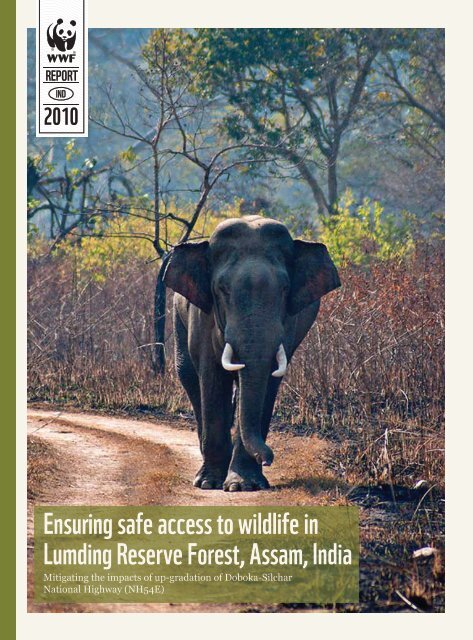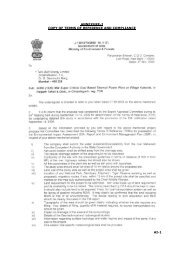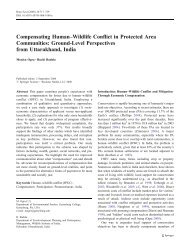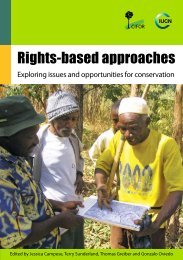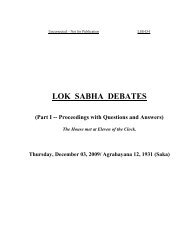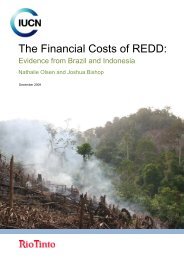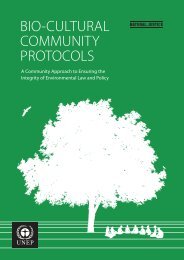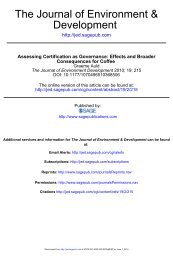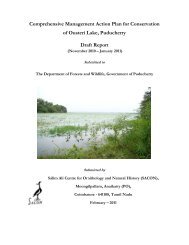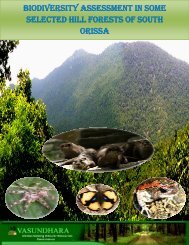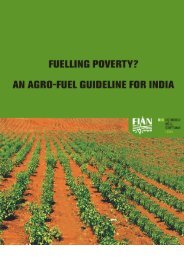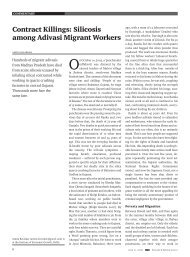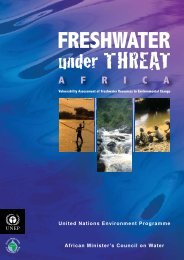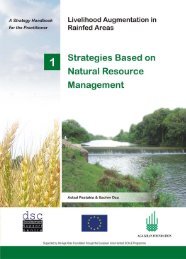Ensuring safe access to wildlife in Lumding Reserve Forest PDF ...
Ensuring safe access to wildlife in Lumding Reserve Forest PDF ...
Ensuring safe access to wildlife in Lumding Reserve Forest PDF ...
Create successful ePaper yourself
Turn your PDF publications into a flip-book with our unique Google optimized e-Paper software.
<strong>Ensur<strong>in</strong>g</strong> <strong>safe</strong> <strong>access</strong> <strong>to</strong> <strong>wildlife</strong> <strong>in</strong><br />
Lumd<strong>in</strong>g <strong>Reserve</strong> <strong>Forest</strong>, Assam, India<br />
Mitigat<strong>in</strong>g the impacts of up-gradation of Doboka-Silchar<br />
National Highway (NH54E)
Citation:<br />
S<strong>in</strong>gh A.P., S<strong>in</strong>gh A.K., Mishra D.K., Bora P.,Sharma A., 2010. <strong>Ensur<strong>in</strong>g</strong> <strong>safe</strong> <strong>access</strong> <strong>to</strong> <strong>wildlife</strong> <strong>in</strong><br />
Lumd<strong>in</strong>g <strong>Reserve</strong> <strong>Forest</strong>, Assam, India, Mitigat<strong>in</strong>g the impacts of up-gradation of Doboka-Silchar<br />
National Highway (NH54E), WWF-India<br />
Cover image © Anil Cherukupalli/ WWF-India<br />
Copyright © 2010- All rights reserved<br />
WWF-India<br />
172-B, Lodi Estate<br />
New Delhi 110 003, India<br />
Tel. +91-11-4150 4814<br />
Website: www.wwf<strong>in</strong>dia.org<br />
Published: November 2010<br />
<strong>Ensur<strong>in</strong>g</strong> <strong>safe</strong> <strong>access</strong> <strong>to</strong> <strong>wildlife</strong> <strong>in</strong><br />
Lumd<strong>in</strong>g <strong>Reserve</strong> <strong>Forest</strong>, Assam, India<br />
Mitigat<strong>in</strong>g the impacts of up-gradation of Doboka-Silchar<br />
National Highway (NH54E)<br />
Authors:<br />
A.P. S<strong>in</strong>gh, Executive Eng<strong>in</strong>eer, Uttar Pradesh Irrigation Department<br />
aps<strong>in</strong>gh1957@yahoo.com<br />
A.K. S<strong>in</strong>gh, Super<strong>in</strong>tend<strong>in</strong>g Eng<strong>in</strong>eer, Uttar Pradesh Irrigation Department<br />
ashokarjav@gmail.com<br />
D.K.Mishra, Assistant Eng<strong>in</strong>eer, Uttar Pradesh Irrigation department<br />
dkmishra1963@gmail.com<br />
Dr. Pranab Jyoti Bora, Coord<strong>in</strong>a<strong>to</strong>r, Kaziranga Karbi Landscape (KKL)<br />
Amit Sharma, Coord<strong>in</strong>a<strong>to</strong>r, WWF-India<br />
<strong>Ensur<strong>in</strong>g</strong> <strong>safe</strong> <strong>access</strong> <strong>to</strong> <strong>wildlife</strong> <strong>in</strong> Lumd<strong>in</strong>g RF 2010 page 2 <strong>Ensur<strong>in</strong>g</strong> <strong>safe</strong> <strong>access</strong> <strong>to</strong> <strong>wildlife</strong> <strong>in</strong> Lumd<strong>in</strong>g RF 2010 page 3
© GARGA MOHAN<br />
CONTENTS<br />
Acknowledgements<br />
Executive Summary<br />
A. Introduction<br />
B. Comments on the proposed migration across the<br />
proposed Highway<br />
C. Comments on the proposed passages for wild<br />
animals other than elephants<br />
D. Comments on the proposed mitigation measure<br />
for arboreal mammals<br />
E. Conclusion<br />
6<br />
7<br />
8<br />
10<br />
22<br />
28<br />
29<br />
<strong>Ensur<strong>in</strong>g</strong> <strong>safe</strong> <strong>access</strong> <strong>to</strong> <strong>wildlife</strong> <strong>in</strong> Lumd<strong>in</strong>g RF 2010 page 5<br />
Sambar <strong>in</strong> the Kaziranga Karbi Anglong Landscape
ACKNOWLEDGEMENTS<br />
SUMMARY<br />
For their support, WWF-India would like <strong>to</strong> express its gratitude <strong>to</strong><br />
- Mr. S. C. Chand (IFS) PCCF-Wildlife; Mr. D. M. S<strong>in</strong>gh (IFS) CCF-<br />
Wildlife; Mr.T.V. Reddy (IFS) Conserva<strong>to</strong>r of <strong>Forest</strong>s, Northern Assam<br />
Circle; Mr. P. Das, DFO, Nagaon South Division;<br />
Mr. J. Deka, ACF, Nagaon South Division; <strong>Forest</strong> Department’s staff at<br />
Lanka and Lumd<strong>in</strong>g Range Offices of Nagaon South Division and<br />
Mr. Alok Kumar, Manager Technical, NHAI, PIO, Lumd<strong>in</strong>g.<br />
©GARGA MOHAN<br />
The authors would also like <strong>to</strong> acknowledge the assistance provided<br />
by Mr. P. D. Sharma, Asst. Eng<strong>in</strong>eer, U.P. Irrigation Department for<br />
help<strong>in</strong>g <strong>in</strong> prepar<strong>in</strong>g the primary manuscript; and Mr. Aditya S<strong>in</strong>gh,<br />
Secretary of the Wildlife Savers Society for help<strong>in</strong>g with graphics.<br />
The team would also like <strong>to</strong> thank the WWF-AREAS Programme for<br />
support<strong>in</strong>g this survey.<br />
The Doboka-Silchar National Highway (NH-54E) <strong>in</strong> the northeastern<br />
Indian state of Assam is proposed <strong>to</strong> be upgraded <strong>in</strong><strong>to</strong> a four-lane<br />
highway. This highway bisects the Lumd<strong>in</strong>g <strong>Reserve</strong> <strong>Forest</strong>. The<br />
course of proposed expanded highway is planned almost <strong>in</strong> the same<br />
alignment of the exist<strong>in</strong>g road with smoother and flatter horizontal<br />
and vertical curves. Though the exist<strong>in</strong>g road currently does not affect<br />
the cross<strong>in</strong>g of elephants and other mammals, an upgraded four-lane<br />
highway with <strong>in</strong>creased traffic and speed<strong>in</strong>g vehicles is bound <strong>to</strong> be<br />
un<strong>safe</strong> for wild animals as well as people travell<strong>in</strong>g <strong>in</strong> the vehicles.<br />
Therefore, construction of <strong>safe</strong> passages for wild animals like elephant<br />
and gaur is manda<strong>to</strong>ry. Given this need a team supported by<br />
WWF-India surveyed the area and came up with suggestions for<br />
mitigation measures.<br />
This report details the mitigation measures proposed <strong>to</strong> facilitate<br />
<strong>wildlife</strong> movement. These <strong>in</strong>clude appropriate underpasses for <strong>wildlife</strong><br />
at identified areas, culverts and provision of artificial lianas for arboreal<br />
mammals.<br />
<strong>Ensur<strong>in</strong>g</strong> <strong>safe</strong> <strong>access</strong> <strong>to</strong> <strong>wildlife</strong> <strong>in</strong> Lumd<strong>in</strong>g RF 2010 page 6 <strong>Ensur<strong>in</strong>g</strong> <strong>safe</strong> <strong>access</strong> <strong>to</strong> <strong>wildlife</strong> <strong>in</strong> Lumd<strong>in</strong>g RF 2010 page 7
Figure 1: Map of<br />
Kaziranga Karbi<br />
Anglong Landscape<br />
show<strong>in</strong>g the study area<br />
A.INTRODUCTION<br />
In the northeastern Indian state of Assam the exist<strong>in</strong>g one-lane<br />
Doboka-Silchar National Highway (NH-54E) is proposed <strong>to</strong> be<br />
upgraded <strong>in</strong><strong>to</strong> four-lane highway. This highway currently bisects<br />
the Lumd<strong>in</strong>g <strong>Reserve</strong> <strong>Forest</strong> (RF) between cha<strong>in</strong>age km32.787 <strong>to</strong><br />
km57.40. The proposed expanded highway is planned almost <strong>in</strong><br />
the same alignment of the exist<strong>in</strong>g road with smoother and flatter<br />
horizontal and vertical curves. Lumd<strong>in</strong>g RF with an area of 22,403<br />
hectare is an important <strong>wildlife</strong> habitat <strong>in</strong> Assam’s Nagaon district.<br />
It stretches through Lanka and Lumd<strong>in</strong>g ranges of Nagaon South<br />
<strong>Forest</strong> Division and was notified as part of Dhansiri-Lumd<strong>in</strong>g<br />
Elephant <strong>Reserve</strong> <strong>in</strong> 2003. The Lumd<strong>in</strong>g RF is also connected <strong>to</strong> the<br />
Marat-Longri Wildlife Sanctuary (WLS) <strong>in</strong> Karbi Anglong district <strong>in</strong><br />
the east and <strong>to</strong> Langt<strong>in</strong>g Mupa RF <strong>in</strong> the west <strong>in</strong> the North Cachar<br />
Hills district of Assam (Figure 1).<br />
This cont<strong>in</strong>uous stretch of forest acts as a migration route <strong>to</strong> many<br />
<strong>wildlife</strong> especially Asian elephants (Elephas maximus). Elephant<br />
herds of the central and southern part of Karbi Anglong move west<br />
<strong>to</strong>wards the forests of North Cachar Hills, Nagaon and western part<br />
of Karbi Anglong and <strong>in</strong> the reverse direction through this forest.<br />
Field biologists of WWF-India have recorded 37 species of mammals<br />
<strong>in</strong> Lumd<strong>in</strong>g RF which <strong>in</strong>clude the Bengal tiger (Panthera tigris),<br />
Asian elephant, clouded leopard (Neofelis nebulosa), and western<br />
hoolock gibbon (Hylobates hoolock).<br />
Currently, the bisection of the entire reach of the Lumd<strong>in</strong>g RF – an<br />
important elephant habitat, by the present road has not severely<br />
affected the migration/ movement of elephants. The elephants<br />
can, and <strong>in</strong> fact are, cross<strong>in</strong>g the exist<strong>in</strong>g road at many locations<br />
along the entire stretch of 24.6km without any noticable problems.<br />
Currently the road traffic is almost nil dur<strong>in</strong>g night hours and very<br />
low dur<strong>in</strong>g the day time with hours restrictions due <strong>to</strong> security<br />
issues. Therefore, no significant obstruction <strong>to</strong> elephants’ movement<br />
is occur<strong>in</strong>g <strong>in</strong> the present scenario. However, once the road is<br />
upgraded and traffic <strong>in</strong>tensity and speed <strong>in</strong>creases the <strong>access</strong> <strong>to</strong><br />
elephants across the highway is bound <strong>to</strong> become difficult and<br />
un<strong>safe</strong>. There are chances of elephants gett<strong>in</strong>g hit by speed<strong>in</strong>g<br />
vehicles, and result<strong>in</strong>g <strong>in</strong>jury or death <strong>to</strong> elephants as well as<br />
the people travell<strong>in</strong>g <strong>in</strong> those vehicles. Hence establishment of<br />
appropriate <strong>safe</strong> passages are required for the elephants <strong>to</strong> cross the<br />
proposed expanded highway successfully.<br />
Apart from elephants, other wild animals that cross this road<br />
from time <strong>to</strong> time are gaur (Bos gaurus), bark<strong>in</strong>g deer (Muntiacus<br />
muntjak) and sambar (Rusa unicolor). This is possible only due the<br />
low <strong>in</strong>tensity of the vehicular traffic on the road as described above.<br />
These animals also require appropriate <strong>safe</strong> passages <strong>to</strong> cross the<br />
proposed expanded highway.<br />
The <strong>to</strong>pography of the terra<strong>in</strong> with<strong>in</strong> the Lumd<strong>in</strong>g RF is semi-hilly<br />
and densely vegetated. The road passes along the ridge and partly<br />
on the flat hill slopes. At all cross<strong>in</strong>gs of the natural streams, cross<br />
dra<strong>in</strong>age structures like pipe culverts, slab culverts, box culverts<br />
and pier & abutment type bridges are proposed as part of the road<br />
expansion.<br />
A team made up of WWF-India staff along with officials from the<br />
<strong>Forest</strong> Department, Government of Assam and officials of NHAI<br />
made a jo<strong>in</strong>t visit <strong>to</strong> the above mentioned stretch of this highway <strong>to</strong><br />
assess the situation and come up with recommendations.<br />
<strong>Ensur<strong>in</strong>g</strong> <strong>safe</strong> <strong>access</strong> <strong>to</strong> <strong>wildlife</strong> <strong>in</strong> Lumd<strong>in</strong>g RF 2010 page 8 <strong>Ensur<strong>in</strong>g</strong> <strong>safe</strong> <strong>access</strong> <strong>to</strong> <strong>wildlife</strong> <strong>in</strong> Lumd<strong>in</strong>g RF 2010 page 9
B. COMMENTS ON THE PROPOSED MIGRATION<br />
ACROSS THE PROPOSED HIGHWAY<br />
Table-1: Details of the passages for the elephants<br />
a)Bridge at km44.975<br />
b)Bridge at km51.645<br />
(1) There is no dedicated passage proposed for the elephants<br />
across the proposed expanded highway <strong>in</strong> the entire stretch between<br />
km32.787 <strong>to</strong> km57.46 with<strong>in</strong> the Lumd<strong>in</strong>g RF. At two locations<br />
viz. at km44.975 and km51.645, the head-room below the slab and<br />
the span of the open<strong>in</strong>gs of the bridges on rivers is proposed <strong>to</strong> be<br />
<strong>in</strong>creased so that the elephants can cross below the road bridge. The<br />
details of the proposed bridges are as follows:<br />
In this bridge six spans, with end spans of 30m each and four middle<br />
spans of 40m each (30+4x40+30) are proposed with a head-room<br />
of 13m. The terra<strong>in</strong> along the river course and <strong>in</strong> the sides of the<br />
river near the bridge is also very good from the elephants’ movement<br />
po<strong>in</strong>t of view. The cross dra<strong>in</strong>age structure, 220m long with six<br />
40mX13m open<strong>in</strong>gs should be appropriate for an elephants’ herd<br />
<strong>to</strong> cross through it. It should however be ensured that the proposed<br />
height of the bridge rema<strong>in</strong>s available <strong>in</strong> at least 80% width of<br />
the passage.<br />
In this bridge four spans, end spans of 30m each and two middle<br />
spans of 40m each (30+2x40+30) are proposed with a head-room of<br />
10m. Here also the terra<strong>in</strong> along the river course and <strong>in</strong> the sides of<br />
the river near the road bridge is also very good from the elephants’<br />
movement po<strong>in</strong>t of view. This cross dra<strong>in</strong>age structure, 140m<br />
long, with four 40mX10m open<strong>in</strong>gs shall be appropriate for the<br />
elephants’ herd <strong>to</strong> cross through it. Aga<strong>in</strong> it should be ensured that<br />
the proposed height of the bridge rema<strong>in</strong>s available <strong>in</strong> at least 80%<br />
width of the passage.<br />
(2) At other locations of the highway, open<strong>in</strong>gs rang<strong>in</strong>g from<br />
6m <strong>to</strong> 25m are proposed <strong>in</strong> different cross dra<strong>in</strong>age structures.<br />
These bridges can be modified <strong>to</strong> be used as elephant passage, <strong>to</strong><br />
create a more connected habitat, which is already on the verge of<br />
fragmentation due <strong>to</strong> the proposed four lane highway. Table 1 shows<br />
the spac<strong>in</strong>g of the proposed structures and their open<strong>in</strong>g size vis-avis<br />
proposed modifications with reference <strong>to</strong> elephant passage -<br />
Sr.<br />
No.<br />
Location of<br />
the cross<br />
dra<strong>in</strong>age<br />
structure<br />
(Km)<br />
AS PER N.H.A.I.<br />
Spac<strong>in</strong>g<br />
between<br />
the<br />
passage<br />
(Km )<br />
Height<br />
(m)<br />
Open<strong>in</strong>g Size<br />
(m)<br />
Proposed m<strong>in</strong>imum<br />
size of<br />
Passage (Nos X<br />
Width X<br />
Height)<br />
Ideal size of<br />
the passage<br />
(Nos X<br />
Width X<br />
Height<br />
Remark<br />
1 32.787 NA NA NA NA NA Start of the RF<br />
2 35.800 3.013<br />
(first passage)<br />
3 40.4 4.6<br />
4 44.379 3.979 Not<br />
Known<br />
5 44.975 0.596 13.0 30+4x40+30=<br />
220 m<br />
4.5 2x6 1x25X6 2x25X6 Two open<strong>in</strong>gs side by<br />
side will have more<br />
visibility of other side<br />
of forest which is likely<br />
<strong>to</strong> facilitate <strong>wildlife</strong><br />
movement .<br />
A new passage <strong>in</strong> the form of an overpass for the elephants <strong>in</strong> the<br />
natural exist<strong>in</strong>g ground should be provided by encas<strong>in</strong>g the road as<br />
a cut and cover section (Tunnel ) <strong>in</strong> a reach of 300 m. Please refer<br />
Sketch No-1<br />
Evidences of elephant<br />
cross<strong>in</strong>g on the road<br />
between km 35.8 <strong>to</strong><br />
44.379.So one passage<br />
is suggested at this<br />
location<br />
1x6 1x25x6 2x25X6 Two open<strong>in</strong>gs side by<br />
side will have more<br />
visibility of other side<br />
of forest<br />
Already provided<br />
passage size is O.K.<br />
Already provided<br />
passage<br />
size is O.K.<br />
6 49.600 4.624 6.0 1x25 1x25X6 2x25X6 Two open<strong>in</strong>gs side by<br />
side will have more<br />
visibility of other side<br />
of forest<br />
7 50.900 1.30 6.0 1x25 1x25X6 2x25X6 --do--<br />
8 51.645 0.745 10.0 30+2x40+30<br />
=140 m<br />
Already provided<br />
passage size is O.K.<br />
Already provided<br />
passage<br />
size is O.K.<br />
9 53.725 2.08 6.0 1x25 1x25X6 2x25X6 Two Nos open<strong>in</strong>g side<br />
by side will have more<br />
visibility of other side<br />
of forest<br />
10 55.125 1.40 6.0 1x25 1x25X6 2x25X6 --do--<br />
11 57.400 2.275<br />
(End <strong>to</strong><br />
last passage)<br />
24.613<br />
NA NA NA NA End of RF<br />
NA<br />
NA<br />
<strong>Ensur<strong>in</strong>g</strong> <strong>safe</strong> <strong>access</strong> <strong>to</strong> <strong>wildlife</strong> <strong>in</strong> Lumd<strong>in</strong>g RF 2010 page 10 <strong>Ensur<strong>in</strong>g</strong> <strong>safe</strong> <strong>access</strong> <strong>to</strong> <strong>wildlife</strong> <strong>in</strong> Lumd<strong>in</strong>g RF 2010 page 11
(3) Provision of only two passages <strong>in</strong> a stretch of 24.613km<br />
of elephant habitat is not at all sufficient, as presently<br />
elephants cross through almost the entire stretch of this road. More<br />
elephant passages at suitable locations are required. At km49.6,<br />
50.9, 53.725, and 55.125, bridges with s<strong>in</strong>gle barrels of 25m width<br />
x 6m height and at km35.8, bridge with tw<strong>in</strong> barrels of 6m width<br />
x 4.5m height are proposed at cross dra<strong>in</strong>age locations which are<br />
likely <strong>to</strong> facilitate <strong>wildlife</strong> movement. At km44.379, <strong>in</strong> spite of clear<br />
evidences of the elephants cross<strong>in</strong>g the road near exist<strong>in</strong>g <strong>to</strong>rrent,<br />
NHAI has proposed a narrow culvert of only 6m width. It is advised<br />
<strong>to</strong> have an appropriate elephant passage at this location <strong>to</strong>o.<br />
Figure 2: Schematic<br />
diagram show<strong>in</strong>g<br />
arrangement <strong>to</strong><br />
accomodate 6m high<br />
elephant passage <strong>in</strong><br />
areas with limited land<br />
availability<br />
boundary <strong>to</strong> allow rais<strong>in</strong>g of the adjo<strong>in</strong><strong>in</strong>g embankment for 6m high<br />
passage (Figure 2).<br />
(4) The ma<strong>in</strong> features for the acceptability of the passage<br />
beneath the road (underpass) by the elephants is the<br />
openness of the structure. The ma<strong>in</strong> repell<strong>in</strong>g fac<strong>to</strong>rs for the<br />
passage are – (a) the barrier effect due <strong>to</strong> the road, (b) tunnel<br />
syndrome due <strong>to</strong> the underpass and (c) the disturbance level by the<br />
vision and the sound of frequent<strong>in</strong>g traffic.<br />
The openness of the passage and the vision of the other side play an<br />
important role <strong>in</strong> mak<strong>in</strong>g the structure acceptable <strong>to</strong> the elephants.<br />
The depth of the structure (road width) is around 22m at the bridge<br />
location. Two barrels of 25m width and m<strong>in</strong>imum 6m height are<br />
proposed at all the locations which would be of ideal size for <strong>safe</strong><br />
passage of elephant herds. Two 25m wide, 22m long and 6m high<br />
passages shall provide sufficient open<strong>in</strong>g for elephants’ movement.<br />
In a recent judgment <strong>in</strong> IA No 2147-2148 <strong>in</strong> WP(C) no 202/ 1995 on<br />
the issue of wild elephants’ migration along Chilla-Motichur corridor<br />
across the proposed four-lane highway (National Highway-54<br />
connect<strong>in</strong>g Delhi <strong>to</strong> Dehradun) with<strong>in</strong> the Rajaji National Park <strong>in</strong><br />
the state of Uttrakhand, the Hon’ble Supreme Court has directed<br />
that the height of the passage be kept at least 6m.<br />
(5)It was <strong>in</strong>formed by the National Highways Authority of<br />
India (NHAI) officers that the land width at km35.8 is not<br />
sufficient <strong>to</strong> raise the height of passage from 4.5m <strong>to</strong> 6m, as the<br />
side slopes of the embankment will encroach upon the forest land.<br />
It is advised that this location should be reta<strong>in</strong>ed at its present state<br />
for the <strong>safe</strong> passage of elephants, as the surround<strong>in</strong>g landscape<br />
strongly advocates for elephants’ passage at this location. Presently<br />
they are cross<strong>in</strong>g through the road. To overcome the land constra<strong>in</strong>t,<br />
a reta<strong>in</strong><strong>in</strong>g wall of suitable height can be constructed at the land<br />
Figure 3: Isometric<br />
view of the natural<br />
passage over the<br />
underground road <strong>in</strong><br />
the forest<br />
(6)In a 24.613km long stretch of forest, passages with less<br />
than 5km spac<strong>in</strong>g are desirable for ma<strong>in</strong>ta<strong>in</strong><strong>in</strong>g the connectivity<br />
of the habitat. Therefore, one more suitable passage is required<br />
between km35.8 <strong>to</strong> km44.379 (8.579km) which is likely <strong>to</strong><br />
help ma<strong>in</strong>ta<strong>in</strong> better connectivity. The best passage for animal<br />
movement, particularly the elephants, is the natural terra<strong>in</strong>. In this<br />
section the road near km40.4 can be accommodated <strong>in</strong> a tunnel<br />
section (cut and cover) <strong>in</strong> suitable length, leav<strong>in</strong>g the elephants’<br />
movement unaffected through the adjo<strong>in</strong><strong>in</strong>g natural ground. The<br />
location of the passage is selected <strong>in</strong> such a way that the water<br />
collected <strong>in</strong> the underground portion of the passage is dra<strong>in</strong>ed <strong>to</strong><br />
lower areas through pipes laid laterally, as the terra<strong>in</strong> is hilly. The<br />
details are shown <strong>in</strong> Figure 3 .<br />
<strong>Ensur<strong>in</strong>g</strong> <strong>safe</strong> <strong>access</strong> <strong>to</strong> <strong>wildlife</strong> <strong>in</strong> Lumd<strong>in</strong>g RF 2010 page 12 <strong>Ensur<strong>in</strong>g</strong> <strong>safe</strong> <strong>access</strong> <strong>to</strong> <strong>wildlife</strong> <strong>in</strong> Lumd<strong>in</strong>g RF 2010 page 13
Figure 4: View of an<br />
eco-friendly passage<br />
below a road bridge <strong>in</strong><br />
Colorado, USA<br />
It is suggested that some additions be made <strong>to</strong> accommodate<br />
ecological features <strong>in</strong> the proposed passages for the elephants<br />
such as:<br />
(a)Side Rail<strong>in</strong>gs of the road bridge<br />
In the road bridge over the elephants’ passage, a 2.5m high opaque<br />
sidewall rail<strong>in</strong>g shall be provided at the side-edges of the bridge<br />
and along the approaches, with an objective of not disturb<strong>in</strong>g<br />
aesthetically, the cross<strong>in</strong>g elephants <strong>in</strong> the daytime and restrict<strong>in</strong>g<br />
the glare of highway traffic’s headlights dur<strong>in</strong>g the night. This<br />
opaque barrier with some sound dampen<strong>in</strong>g devices will also restrict<br />
the noise generated by the pass<strong>in</strong>g vehicles.<br />
(b)Landscap<strong>in</strong>g<br />
Landscap<strong>in</strong>g of the area will help reduce the impact of the new<br />
structure <strong>in</strong> the habitat. In the state of Colorado <strong>in</strong> USA a road<br />
bridge is constructed over a <strong>to</strong>rrent. The landscap<strong>in</strong>g below the<br />
bridge is done <strong>in</strong> such a way that it does not have any negative<br />
impact for the <strong>in</strong>habit<strong>in</strong>g <strong>wildlife</strong> <strong>in</strong> their natural movement. The<br />
image of the bridge is shown <strong>in</strong> Figure 4.<br />
(c) Construction period of the structure<br />
The construction period of the passage <strong>in</strong> the area should be so<br />
selected that the elephants are away on seasonal migration. This will<br />
reduce any disturbance <strong>to</strong> elephants due <strong>to</strong> construction activities,<br />
and also reduce chances of result<strong>in</strong>g human-elephant conflict with<br />
the construction workers.<br />
(d) Construction Techniques<br />
Precast construction techniques will reduce the construction time<br />
of the structures drastically hence will not compel the elephants <strong>to</strong><br />
leave the area due <strong>to</strong> construction activities related disturbance.<br />
With precast construction techniques, the proposed bridges can be<br />
constructed with<strong>in</strong> six months.<br />
(e)Attractions for the elephants<br />
To attract the elephants <strong>to</strong>wards the structure for them <strong>to</strong> start us<strong>in</strong>g<br />
it, some sort of attractions can be provided like -<br />
(i) Creat<strong>in</strong>g some water ponds near the passage<br />
(ii) Plant<strong>in</strong>g some favourable fodder trees on the approach of the<br />
passage<br />
(iii) Periodically allow<strong>in</strong>g domestic or Kunki elephants’ movement<br />
along the passage. Their fresh dung piles and ur<strong>in</strong>e will attract the<br />
wild elephants <strong>to</strong> come around the passage because the presence<br />
of fresh dung piles and ur<strong>in</strong>e is likely <strong>to</strong> create a familiar feel<strong>in</strong>g<br />
among the wild elephants.<br />
<strong>Ensur<strong>in</strong>g</strong> <strong>safe</strong> <strong>access</strong> <strong>to</strong> <strong>wildlife</strong> <strong>in</strong> Lumd<strong>in</strong>g RF 2010 page 14 <strong>Ensur<strong>in</strong>g</strong> <strong>safe</strong> <strong>access</strong> <strong>to</strong> <strong>wildlife</strong> <strong>in</strong> Lumd<strong>in</strong>g RF 2010 page 15
(f)Lateral visibility under the passage<br />
It is <strong>in</strong>dicated by the NHAI officials that the underpass bridges will<br />
be supported on the RCC wall type piers. The wall type piers will<br />
create problem of lateral visibility of the cross<strong>in</strong>g elephant herd. It is<br />
suggested that isolated end piers with cross beam at the <strong>to</strong>p should<br />
be provided <strong>in</strong>stead of wall type piers (Figure 5). This will provide<br />
better lateral visibility and movement <strong>to</strong> the cross<strong>in</strong>g herd below the<br />
bridge. It is also <strong>in</strong>formed by the NHAI officials that <strong>in</strong> place of the<br />
median between the left and right halves of the deck slab, about 1m<br />
wide open<strong>in</strong>g shall be provided along the full length of the bridge.<br />
This should be avoided <strong>to</strong> m<strong>in</strong>imize the noise disturbance level for<br />
the elephants us<strong>in</strong>g the passage, as the open<strong>in</strong>g will give way <strong>to</strong><br />
disturb<strong>in</strong>g sound propagation.<br />
Figure 6 – Elephant<br />
underpass with solid<br />
wall type pier<br />
An elephant underpass has been constructed across the highway<br />
adjo<strong>in</strong><strong>in</strong>g the Manas National Park <strong>in</strong> Assam, a pho<strong>to</strong> of which<br />
is shown <strong>in</strong> Figure 6. The central pier <strong>in</strong> this underpass can be<br />
modified as depicted <strong>in</strong> Figure 7 <strong>to</strong> facilitate lateral visibility for the<br />
benefit of pass<strong>in</strong>g elephant herds.<br />
Figure 5 – Diagram of<br />
isolated and wall type<br />
piers <strong>in</strong> underpass<br />
Figure 7 – Elephant<br />
underpass <strong>in</strong> which<br />
portal type piers<br />
replace wall type<br />
thereby provid<strong>in</strong>g<br />
lateral visibility<br />
<strong>Ensur<strong>in</strong>g</strong> <strong>safe</strong> <strong>access</strong> <strong>to</strong> <strong>wildlife</strong> <strong>in</strong> Lumd<strong>in</strong>g RF 2010 page 16 <strong>Ensur<strong>in</strong>g</strong> <strong>safe</strong> <strong>access</strong> <strong>to</strong> <strong>wildlife</strong> <strong>in</strong> Lumd<strong>in</strong>g RF 2010 page 17
(g)Speed limit<br />
The restriction of the speed of vehicles us<strong>in</strong>g the highway above the<br />
underpass should be limited <strong>to</strong> maximum 40km/ hour so that the<br />
sound effect is m<strong>in</strong>imum.<br />
(h)Low beam movement of vehicles <strong>in</strong> the night<br />
As the highway is divided <strong>in</strong><strong>to</strong> two lanes, the vehicles us<strong>in</strong>g the<br />
highway above the underpass should be forced <strong>to</strong> move with low<br />
beam dur<strong>in</strong>g the night, which will reduce the glare effect of the<br />
vehicles headlight on the cross<strong>in</strong>g elephants.<br />
(i)Ban on blow<strong>in</strong>g of horns<br />
A complete ban on blow<strong>in</strong>g of vehicles’ horns along the highway<br />
above the underpass should be enforced.<br />
(j)Ban on the movement of humans <strong>in</strong> the passage<br />
There should be a complete ban on human presence <strong>in</strong> the path<br />
of the elephants. It has been observed that human disturbance <strong>in</strong><br />
or along the passage discourages wild animals <strong>to</strong> use the passage<br />
dur<strong>in</strong>g day time. It is advised that this action be imposed through<br />
appropriate legislation.<br />
Animal kills due <strong>to</strong><br />
vehicle hits<br />
Figure 8 – Elephant<br />
herd cross<strong>in</strong>g the Chilla<br />
Hydro power canal <strong>in</strong><br />
Rajaji National Park,<br />
Uttrakhand, through<br />
a road bridge near the<br />
Soni Sot <strong>to</strong>rrent<br />
As the ra<strong>in</strong>fall <strong>in</strong> the area is high, these creepers can survive on<br />
their own.<br />
On the power canal of the Chilla-Hydro Electric Project <strong>in</strong> the Rajaji<br />
National Park <strong>in</strong> the state of Uttrakhand, several structures like small<br />
bridges, barrels below the canal and super passages are made over<br />
the canal. The herds preferred us<strong>in</strong>g the narrow road bridge<br />
(Figure 8) over long barrels of Duggada dra<strong>in</strong>age cross<strong>in</strong>g (Figure 9).<br />
(k)Road signage near the passage<br />
There should be sufficient road signage written <strong>in</strong> Assamese, H<strong>in</strong>di<br />
and English on both directions of the road with reference <strong>to</strong> the<br />
presence of the elephants nearby. These signages should conta<strong>in</strong><br />
clearly marked word<strong>in</strong>gs like “You are approach<strong>in</strong>g the elephant<br />
passage” and “No horns, elephants are cross<strong>in</strong>g”.<br />
(l) Open<strong>in</strong>g between the deck slabs of the bridge<br />
It is also <strong>in</strong>formed by the NHAI officials that <strong>in</strong> place of the median<br />
between the left and right halves of the deck slab, about 1.0m wide<br />
sky light open<strong>in</strong>g shall be provided along the full length of the<br />
bridge. This should be avoided <strong>to</strong> m<strong>in</strong>imize the noise disturbance<br />
level for the elephants us<strong>in</strong>g the passage, as this open<strong>in</strong>g will give<br />
way <strong>to</strong> disturb<strong>in</strong>g sound propagation.<br />
Figure 9 – Barrels<br />
of Duggada dra<strong>in</strong>age<br />
cross<strong>in</strong>g on the Chilla<br />
Hydro Power Canal <strong>in</strong><br />
Rajaji National Park,<br />
Uttarakhand<br />
(m) Camouflag<strong>in</strong>g the walls of the structures with<br />
wall creepers<br />
The faces of the walls and the slabs of the structure can be suitably<br />
camouflaged by wall creepers. These creepers climb on the wall<br />
surface and give an appearance similar <strong>to</strong> the surround<strong>in</strong>g forest.<br />
<strong>Ensur<strong>in</strong>g</strong> <strong>safe</strong> <strong>access</strong> <strong>to</strong> <strong>wildlife</strong> <strong>in</strong> Lumd<strong>in</strong>g RF 2010 page 18 <strong>Ensur<strong>in</strong>g</strong> <strong>safe</strong> <strong>access</strong> <strong>to</strong> <strong>wildlife</strong> <strong>in</strong> Lumd<strong>in</strong>g RF 2010 page 19
ENSURING<br />
SAFE ACCESS<br />
© DIPANKAR GHOSE/WWF-INDIA<br />
Elephant herds are us<strong>in</strong>g almost the entire<br />
stretch of the road as a part of their habitat.<br />
Currently, the road traffic is very low<br />
therefore, there is no significant obstruction<br />
<strong>to</strong> elephants’ movement. However, once the<br />
road is upgraded and traffic <strong>in</strong>tensity and<br />
speed <strong>in</strong>creases, the <strong>access</strong> <strong>to</strong> elephants across<br />
the highway is bound <strong>to</strong> become difficult and<br />
un<strong>safe</strong>. Hence establishment of appropriate<br />
<strong>safe</strong> passages are manda<strong>to</strong>ry for the elephants<br />
and other <strong>wildlife</strong> <strong>to</strong> cross the proposed<br />
expanded highway successfully.
C. COMMENTS ON THE PROPOSED PASSAGES<br />
FOR WILD ANIMALS OTHER THAN ELEPHANTS<br />
Figure 11 - View of the<br />
underpass with side<br />
space from a different<br />
location<br />
Figure 10 - Isometric<br />
view of the proposed<br />
underpass below the<br />
highway<br />
(1)Apart from elephants there are other wild animals<br />
us<strong>in</strong>g Lumd<strong>in</strong>g RF. Currently they are cross<strong>in</strong>g the exist<strong>in</strong>g road<br />
at random locations, between the gaps <strong>in</strong> the mov<strong>in</strong>g traffic on the<br />
road. The underpass below the road is the only alternative for the<br />
<strong>wildlife</strong> <strong>to</strong> cross the proposed expanded highway. The passages of<br />
2.5m width and 2m height are large enough for other wild animals<br />
of the area. Generally, prey species do not use such passages as<br />
they apprehend gett<strong>in</strong>g trapped whereas wild preda<strong>to</strong>rs use such<br />
passages more confidently.<br />
(2)In the entire patch of the forest the NHAI has provided<br />
pipe culverts, box culverts, slab culverts and big bridges on<br />
the natural dra<strong>in</strong>ages across the highway. They have provided<br />
different sized open<strong>in</strong>gs <strong>in</strong> the structures. The proposed small slab/<br />
box culverts with m<strong>in</strong>imum open<strong>in</strong>g size of 2.5m width and 2m<br />
height can well be used as the cross<strong>in</strong>g passages by wild animals<br />
other than elephants (Figure 10). In the passage where there is<br />
cont<strong>in</strong>uous runn<strong>in</strong>g of water, some side space should be made for<br />
the reptiles and amphibians (Figure 11).<br />
(3)The spac<strong>in</strong>g of the proposed culverts by NHAI ranges<br />
from 200m <strong>to</strong> 800m. The m<strong>in</strong>imum spac<strong>in</strong>g for the passage should<br />
be around 500m. With this, the cross<strong>in</strong>g animals will sense and<br />
remember the location and with<strong>in</strong> short time they will start us<strong>in</strong>g<br />
them regularly.<br />
(4) For this a detailed analysis has been shown <strong>in</strong> the follow<strong>in</strong>g<br />
chart so that the passages of size 2.5m x 2m are made available <strong>to</strong><br />
small animals with<strong>in</strong> a range of 500m for cross<strong>in</strong>g the highway.<br />
(5) In a reach of 24.6km, 51 cross dra<strong>in</strong>age structures are be<strong>in</strong>g<br />
provided by the NHAI for meet<strong>in</strong>g the dra<strong>in</strong>age requirements. For<br />
ma<strong>in</strong>ta<strong>in</strong><strong>in</strong>g proper connectivity of the habitat by provid<strong>in</strong>g 2.5m<br />
wide and 2m deep underground passage at approximately every<br />
500m across the highway, 36 proposed cross dra<strong>in</strong>age structures<br />
should be modified <strong>to</strong> the required dimensions. In addition seven<br />
new structures are be<strong>in</strong>g suggested.<br />
<strong>Ensur<strong>in</strong>g</strong> <strong>safe</strong> <strong>access</strong> <strong>to</strong> <strong>wildlife</strong> <strong>in</strong> Lumd<strong>in</strong>g RF 2010 page 22 <strong>Ensur<strong>in</strong>g</strong> <strong>safe</strong> <strong>access</strong> <strong>to</strong> <strong>wildlife</strong> <strong>in</strong> Lumd<strong>in</strong>g RF 2010 page 23
Table-2, Details of the passages for the small wild life of the area<br />
Sr.<br />
No.<br />
Details of the structure as proposed by N.H.A.I. Spac<strong>in</strong>g Proposed<br />
Location of<br />
the cross<br />
dra<strong>in</strong>age<br />
structure<br />
(Km)<br />
Type of<br />
Structure<br />
Open<strong>in</strong>g<br />
Size<br />
(m)<br />
Height<br />
(m)<br />
cha<strong>in</strong>age<br />
of the<br />
passage<br />
@ approx<br />
0.5 Km<br />
c/c<br />
Modified<br />
spac<strong>in</strong>g of<br />
the passage<br />
Ideal Size<br />
of the passage<br />
for<br />
small wild<br />
life<br />
(Width X<br />
Height)<br />
Remark<br />
Sr.<br />
No.<br />
Details of the structure as proposed by N.H.A.I. Spac<strong>in</strong>g Proposed<br />
Location of<br />
the cross<br />
dra<strong>in</strong>age<br />
structure<br />
(Km)<br />
Type of<br />
Structure<br />
Open<strong>in</strong>g<br />
Size<br />
(m)<br />
Height<br />
(m)<br />
cha<strong>in</strong>age<br />
of the<br />
passage<br />
@ approx<br />
0.5 Km<br />
c/c<br />
Modified<br />
spac<strong>in</strong>g of<br />
the passage<br />
Ideal Size<br />
of the passage<br />
for<br />
small wild<br />
life<br />
(Width X<br />
Height)<br />
Remark<br />
1 32.787 NA NA NA NA 32.787 NA NA Start of the RF<br />
2 New Location NA NA NA NA 33.48 0.693 2.5x2 New passage for small<br />
animals<br />
3 34.185 Not<br />
Known<br />
1x1.8 2.0 1.398 34.185 0.705 2.5x2 Modified new passages<br />
for small animals<br />
4 34.485 N.K 1x1.5 2.0 0.3 NA NA NA NA<br />
21 40.831 Slab<br />
Culvert<br />
22 41.705 Slab<br />
Culvert<br />
1x5 N.K 0.731 40.831 0.431 2.5x2 Modified<br />
new passages for small<br />
animals<br />
1x2 N.K 0.874 41.705 0.874 2.5x2 --do--<br />
5 34.985 N.K 1x1.5 2.0 0.5 34.985 0.800 2.5x2 Modified new passages<br />
for small animals<br />
23 New<br />
Location<br />
NA NA NA NA 42.26 0.555 2.5x2 New passage for small<br />
animals<br />
6 35.238 N.K 1x1.5 2.0 0.253 NA NA NA NA<br />
7 35.530 N.K 1x1.5 1.5 0.292 35.53 0.545 2.5x2 Modified new passages<br />
for small animals<br />
8 35.546 N.K 1x1.5 2.0 0.016 NA NA NA NA<br />
9 35.800 N.K 2x6 4.5 0.254 35.8 0.27 25x6 Modified new passage<br />
for elephant<br />
10 36.045 N.K 1x1.8 2.0 0.245 NA NA NA NA<br />
11 New<br />
Location<br />
NA NA NA NA 36.45 0.65 2.5x2 New passage for small<br />
animals<br />
24 42.828 Pipe<br />
Culvert<br />
1x1.2 N.K 1.123 42.828 0.568 2.5x2 Modified new passages<br />
for small animals<br />
25 New<br />
Location<br />
NA NA NA NA 43.293 0.463 2.5x2 New passage for small<br />
animals<br />
26 43.758 Slab<br />
Culvert<br />
1x2 N.K 0.93 43.758 0.463 2.5x2 Modified new passages<br />
for small animals<br />
27 44.082 Slab 1x6 N.K 0.324 NA NA NA NA<br />
Culvert<br />
28 44.379 Slab<br />
Culvert<br />
1x6 N.K. 0.297 44.379 0.621 25x6 Modified new passage<br />
for elephants<br />
12 37.116 N.K 1x1.8 2..0 1.071 37.116 0.666 2.5x2 Modified new passages<br />
for small animals<br />
29 44.975 Bridge 3030+<br />
4x40+30<br />
13.0 0.596 44.975 0.596 220X13 Proposed Elephant<br />
Passage<br />
13 37.61 N.K 1x1.5 2.0 0.494 37.61 0.494 2.5x2 --do--<br />
14 38.35 N.K 1x1.6 2.0 0.74 38.35 0.74 2.5x2 --do--<br />
30 45.261 Slab<br />
Culvert<br />
1x2 N.K 0.286 NA NA NA NA<br />
15 38.85 N.K 1x1.8 3.0 0.5 38.85 0.50 2.5x2 --do--<br />
16 39.08 N.K 1x1.5 2.5 0.23 NA NA NA NA<br />
17 39.050 N.K. 1x1.5 2.0 0.03 NA NA NA NA<br />
18 New<br />
Location<br />
NA NA NA NA 39.475 0.625 2.5x2 New passage for small<br />
animals<br />
19 40.100 Slab<br />
Culvert<br />
1x2 N.K 1.05 40.1 0.625 2.5x2 Modified new passages<br />
for small animals<br />
20 40.400 A new passage as overpass for the elephants <strong>in</strong> the<br />
natural exist<strong>in</strong>g ground be provided by encas<strong>in</strong>g<br />
the road as a cut and cover section( Tunnel ) <strong>in</strong> a<br />
reach of 300 m. Please refer Sketch No---.<br />
40.4 0.300 Cut and<br />
cover section<br />
Proposed new passage<br />
for elephants<br />
31 New<br />
Location<br />
NA NA NA NA 45.475 0.5 2.5x2 New passage for small<br />
animals<br />
32 45.984 Slab<br />
Culvert<br />
1x3 N.K 0.723 45.984 0.509 2.5x2 Modified new passages<br />
for small animals<br />
33 46.650 Slab 1x5 N.K 0.666 46.650 0.666 2.5x2 --do--<br />
Culvert<br />
34 New<br />
Location<br />
NA NA NA NA 47.129 0.479 2x2.5 New passage for small<br />
animals<br />
35 47.609 Slab<br />
Culvert<br />
1x3 N.K 0.959 47.609 0.48 2.5x2 Modified new passages<br />
for small animals<br />
36 47.937 Pipe 1x1.2 N.K 0.328 NA NA NA NA<br />
Culvert<br />
37 48.200 Slab<br />
Culvert<br />
1x5 N.K 0.263 48.2 0.591 2.5x2 Modified new passages<br />
for small animals<br />
38 48.500 Slab<br />
Culvert<br />
1x5 N.K 0.300 48.5 0.3 2.5x2 --do--<br />
<strong>Ensur<strong>in</strong>g</strong> <strong>safe</strong> <strong>access</strong> <strong>to</strong> <strong>wildlife</strong> <strong>in</strong> Lumd<strong>in</strong>g RF 2010 page 24 <strong>Ensur<strong>in</strong>g</strong> <strong>safe</strong> <strong>access</strong> <strong>to</strong> <strong>wildlife</strong> <strong>in</strong> Lumd<strong>in</strong>g RF 2010 page 25
Sr.<br />
No.<br />
Details of the structure as proposed by N.H.A.I. Spac<strong>in</strong>g Proposed<br />
Location of<br />
the cross<br />
dra<strong>in</strong>age<br />
structure<br />
(Km)<br />
Type of<br />
Structure<br />
Open<strong>in</strong>g<br />
Size<br />
(m)<br />
Height<br />
(m)<br />
cha<strong>in</strong>age<br />
of the<br />
passage<br />
@ approx<br />
0.5 Km<br />
c/c<br />
Modified<br />
spac<strong>in</strong>g of<br />
the passage<br />
Ideal Size<br />
of the passage<br />
for<br />
small wild<br />
life<br />
(Width X<br />
Height)<br />
Remark<br />
Sr.<br />
No.<br />
Details of the structure as proposed by N.H.A.I. Spac<strong>in</strong>g Proposed<br />
Location of<br />
the cross<br />
dra<strong>in</strong>age<br />
structure<br />
(Km)<br />
Type of<br />
Structure<br />
Open<strong>in</strong>g<br />
Size<br />
(m)<br />
Height<br />
(m)<br />
cha<strong>in</strong>age<br />
of the<br />
passage<br />
@ approx<br />
0.5 Km<br />
c/c<br />
Modified<br />
spac<strong>in</strong>g of<br />
the passage<br />
Ideal Size<br />
of the passage<br />
for<br />
small wild<br />
life<br />
(Width X<br />
Height)<br />
Remark<br />
39 49.125 Pipe<br />
Culvert<br />
1x5 N.K. 0.625 49.125 0.625 2.5x2 --do--<br />
58 56.362 Slab<br />
Culvert<br />
1x5 N.K 0.279 56.362 0.6 2x2.5 Modified new passages<br />
for small animals<br />
40 49.600 Bridge 1x25 6.5 0.475 49.600 0.475 25x6 Modified New passage<br />
for elephants<br />
59 56.650 Slab<br />
Culvert<br />
1x2 N.K 0.288 56.650 0.288 2x2.5 Modified new passages<br />
for small animals<br />
41 50.068 Slab<br />
Culvert<br />
1x2 N.K 0.468 50.068 0.468 2.5x2 Modified new passages<br />
for small animals<br />
60 57.375 Slab<br />
Culvert<br />
1x5 N.K 0.725 57.375 0.725 2x2.5 --do--<br />
42 50.365 Slab<br />
Culvert<br />
1x2 N.K 0.297 NA NA NA NA<br />
61 57.400 Bridge 30+2x<br />
40+30<br />
N.K. 0.025 NA 0.025 NA End of RF<br />
43 50.611 Slab<br />
Culvert<br />
1x2 N.K 0.246 50.611 0.543 2.5x2 Modified new passages<br />
for small animals<br />
24.613 24.61<br />
44 50.900 Bridge 1x25 6.0 0.289 50.900 0.289 25x6 Modified new passage<br />
for elephants<br />
45 51.075 Slab<br />
Culvert<br />
1x1.5 N.K 0.175 51.075 0.464 2.5x2 Modified new passages<br />
for small animals<br />
46 51.350 Slab 1x1.5 N.K. 0.275 NA NA NA NA<br />
Culvert<br />
47 51.645 Bridge 30+2x4<br />
+30<br />
10.0 0.295 51.645 0.57 140x10 Proposed Elephant<br />
passage<br />
Abbreviations:<br />
N.K. : Not Known, NA : Not Applicable<br />
48 52.346 Slab<br />
Culvert<br />
49 52.787 Slab<br />
Culvert<br />
50 53.262 Slab<br />
Culvert<br />
1x2 N.K 0.701 52.346 0.701 2.5x2 Modified new passages<br />
for small animals<br />
1x6 N.K 0.441 52.787 0.441 2.5x2 --do--<br />
1x6 N.K 0.475 53.262 0.475 2.5x2 --do--<br />
51 53.725 Bridge 1x25 6.0 0.463 53.725 0.463 25x6 Modified new passage<br />
for elephants<br />
52 54.243 Slab<br />
Culvert<br />
53 54.722 Pipe<br />
Culvert<br />
1x2 N.K. 0.518 54.243 0.518 2.5x2 Modified new passages<br />
for small animals<br />
1x1.2 N.K. 0.479 54.722 0.479 2.5x2 --do--<br />
54 55.125 Bridge 1x25 6.0 0.403 55.125 0.403 25x6 Modified new passage<br />
for elephants<br />
55 55.325 Slab<br />
Culvert<br />
56 55.762 Slab<br />
Culvert<br />
57 56.083 Box<br />
Culvert<br />
1x2 N.K 0.2 55.762 NA NA NA<br />
1x3 N.K 0.437 55.762 0.637 2x2.5 Modified new passages<br />
for small animals<br />
2x2 N.K 0.321 NA NA NA NA<br />
<strong>Ensur<strong>in</strong>g</strong> <strong>safe</strong> <strong>access</strong> <strong>to</strong> <strong>wildlife</strong> <strong>in</strong> Lumd<strong>in</strong>g RF 2010 page 26 <strong>Ensur<strong>in</strong>g</strong> <strong>safe</strong> <strong>access</strong> <strong>to</strong> <strong>wildlife</strong> <strong>in</strong> Lumd<strong>in</strong>g RF 2010 page 27
D. COMMENTS ON<br />
PROPOSED MITIGATION<br />
MEASURE FOR ARBOREAL<br />
MAMMALS<br />
Figure 12 – Liana at<br />
the S<strong>in</strong>gapore zoo<br />
Hoolock gibbon, Capped langur,<br />
Stump-tailed macaque and<br />
Pig-tailed macaque<br />
In November 2009, a WWF field team<br />
recorded canopy cont<strong>in</strong>uity over the<br />
road with<strong>in</strong> the stretch from Lankajan<br />
<strong>to</strong> Lumd<strong>in</strong>g at 119 places <strong>in</strong>dicat<strong>in</strong>g that<br />
hoolock gibbons and other arboreal<br />
mammals at that time could cross over at many places over the road<br />
without the fear of be<strong>in</strong>g run over by speed<strong>in</strong>g vehicles. Hoolock<br />
gibbons are terri<strong>to</strong>rial and exclusively arboreal. Any widen<strong>in</strong>g would<br />
immediately remove the exist<strong>in</strong>g 119 sites where canopy cont<strong>in</strong>uity<br />
was recorded dur<strong>in</strong>g November 2009. Even if we were <strong>to</strong> make<br />
canopy bridges, it is doubtful that hoolock gibbons will use them<br />
while heavy traffic is mov<strong>in</strong>g underneath. If the canopy bridges<br />
are not spread all along (<strong>in</strong> fact, at each of those 119 sites), hoolock<br />
gibbons and many other arboreal mammals, be<strong>in</strong>g terri<strong>to</strong>rial, will<br />
not be able <strong>to</strong> use canopy bridges that are not <strong>in</strong>side their own<br />
terri<strong>to</strong>ry. Thus the young dispers<strong>in</strong>g animals from their natal home<br />
ranges would have nowhere <strong>to</strong> go. Therefore we propose two types<br />
of mitigation measures as follows –<br />
(1)A canopy type steel structure with sufficient head-room<br />
(5.5m approximately) for the road traffic may be provided for the<br />
connectivity for arboreal mammals <strong>in</strong> the habitat across the road.<br />
The canopy type steel structure will have <strong>to</strong> be connected <strong>to</strong> the trees<br />
of both sides. It is most likely that the arboreal mammals will use the<br />
canopy. The arrangement is shown <strong>in</strong> Figure 13. These canopy type<br />
steel structures should be covered with natural vegetation.<br />
(2) S<strong>in</strong>gapore zoo has <strong>in</strong>vented an <strong>in</strong>expensive way of mak<strong>in</strong>g<br />
artificial lianas (Figure 12) those can be connected at regular<br />
<strong>in</strong>tervals of 1-2km across the road from tall trees. These lianas can<br />
be made locally and last for many years and almost all arboreal<br />
mammals have been seen <strong>to</strong> use them.<br />
Figure 13 - Isometric<br />
view of the monkey<br />
passage over the<br />
proposed highway<br />
Economic growth is important for a develop<strong>in</strong>g<br />
E. CONCLUSION nation like India which needs <strong>to</strong> lift millions<br />
of people out of poverty. <strong>Ensur<strong>in</strong>g</strong> that this<br />
growth is ecologically susta<strong>in</strong>able and does not jeopardise the wellbe<strong>in</strong>g<br />
of future generations is a challenge that needs <strong>to</strong> be addressed<br />
now. Balanc<strong>in</strong>g the need for rapid <strong>in</strong>frastructure development like<br />
the NH-54E <strong>in</strong> Lumd<strong>in</strong>g RF with the need <strong>to</strong> keep our wilderness<br />
areas from be<strong>in</strong>g fragmented beyond recovery is a typical example<br />
of the type of situation where it is important <strong>to</strong> f<strong>in</strong>d a solution<br />
which will set a future precedent. Towards this end, WWF India<br />
has worked with various stakeholders <strong>to</strong> come up with a w<strong>in</strong>-w<strong>in</strong><br />
formula. This report outl<strong>in</strong>es the mitigation measures that need<br />
<strong>to</strong> be implemented <strong>to</strong> ensure that <strong>wildlife</strong> <strong>in</strong> the Kaziranga-Karbi<br />
Anglong Landscape (which <strong>in</strong>cludes Lumd<strong>in</strong>g RF) is not <strong>to</strong>o<br />
drastically affected by the development of NH-54E. We understand<br />
that this is not the best solution for the <strong>wildlife</strong> concerned. However,<br />
given that the alternative, i.e. keep<strong>in</strong>g this route at its exist<strong>in</strong>g<br />
width is probably not pragmatic, we feel the mitigation measures<br />
suggested here are the best solution. This report is the result of<br />
many hours of discussions, field visits and expert consultations<br />
and we now call upon NHAI, MoEF and Assam FD <strong>to</strong> ensure that<br />
the mitigation measures outl<strong>in</strong>ed <strong>in</strong> this report are implemented<br />
without major changes. We believe this is a test that must be passed<br />
by NHAI <strong>to</strong> prevent future legal challenges on other such l<strong>in</strong>ear<br />
developmental projects <strong>in</strong> critical <strong>wildlife</strong> habitats. We hope that<br />
this spirit of dialogue between a conservation organisation such as<br />
ours and a developmental agency such as NHAI is seen as a model<br />
for other such developmental projects <strong>to</strong> protect India’s beleaguered<br />
wilderness areas.<br />
<strong>Ensur<strong>in</strong>g</strong> <strong>safe</strong> <strong>access</strong> <strong>to</strong> <strong>wildlife</strong> <strong>in</strong> Lumd<strong>in</strong>g RF 2010 page 28 <strong>Ensur<strong>in</strong>g</strong> <strong>safe</strong> <strong>access</strong> <strong>to</strong> <strong>wildlife</strong> <strong>in</strong> Lumd<strong>in</strong>g RF 2010 page 29
Elephant use zone along the study area <strong>in</strong> Lumd<strong>in</strong>g <strong>Reserve</strong><br />
<strong>Forest</strong>, Kaziranga Karbi Anglong Landscape, Assam , India<br />
©GARGA MOHAN
WWF <strong>in</strong> numbers<br />
+100<br />
WWF is <strong>in</strong> over 100<br />
countries on 5 cont<strong>in</strong>ents<br />
+5M<br />
WWF has over 5 million<br />
supporters<br />
1961<br />
WWF was founded <strong>in</strong> 1961<br />
+50,000<br />
WWF has over 50,000 staff<br />
worldwide<br />
ENSURING SAFE ACCESS TO WILDLIFE IN LUMDING RESERVE FOREST, ASSAM,INDIA<br />
IND<br />
© 1986 Panda Symbol WWF-World Wide Fund For Nature (Formerly World Wildlife Fund)<br />
WWF-India Secretariat<br />
172-B Lodi Estate<br />
New Delhi 110003<br />
Tel: 011 4150 4814 Fax: 011 4150 4779<br />
WWW.WWFINDIA.ORG


